Hurricane eMatrix
List of Activity Sheets » Public Safety (Law Enforcement and Emergency Medical Services)
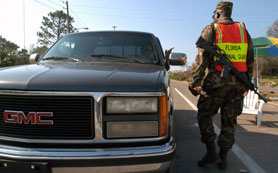
This picture shows actual disaster site work conditions and may not illustrate proper safety and health procedures.
Activity Description
- This activity sheet outlines the hazards to police and emergency medical services (EMS) personnel and other public officials who provide emergency response services.
- For some operations or situations (e.g., search and rescue, removing human and animal remains) other activity sheets also apply; see related activity sheets below.
- Public safety officials are expected to perform their duties under the unusual circumstances that result from hurricanes, such as Katrina and Rita (2005). These circumstances included downed power lines, impassable roads, missing road signs and address indicators, damaged structures, and other results typical of hurricanes.
- Under these conditions, public safety officials direct traffic, process and manage evacuees, settle disputes, arrest criminals, and perform emergency medical services for injured and ill residents. They may travel in vehicles, boats, or on foot, depending on the local conditions.
- Response and recovery workers conducting this operation may be employed by Federal, State, local, and private employers. Review How to Use This Matrix in the introduction for a discussion of how this information may apply to different workers.
About the Activity Sheet
This activity sheet does not provide an in-depth analysis of OSHA standards and regulations and cannot address all hazards. It does not increase or diminish any OSHA requirement or employer obligation under those requirements. It is intended as a guide and quick reference for employers and response and recovery workers. The Matrix captures major activities involved in hurricane response and recovery, highlights many of the hazards associated with them, and recommends beneficial work practices, personal protective equipment (PPE), and other exposure control methods. Employers must evaluate the specific hazards associated with the job/operation at the site where the work is being performed.
Employers are responsible for providing a safe and healthful workplace for their workers. OSHA's role is to assure the safety and health of America's workers by setting and enforcing standards; providing training, outreach, and education; establishing partnerships; and encouraging continual improvement in workplace safety and health.
The Hazard Exposure and Risk Assessment Matrix for Hurricane Response and Recovery Work provides a general overview of particular topics related to current OSHA standards. It does not alter or determine compliance responsibilities in OSHA standards or the Occupational Safety and Health Act of 1970, or the equivalent State Plan standards and requirements. Because interpretations and enforcement policy may change over time, you should consult current OSHA/State Plan administrative interpretations and decisions by the Occupational Safety and Health Review Commission and the courts for additional guidance on OSHA compliance requirements. Employers should modify their procedures as appropriate when additional, relevant information becomes available.
General Recommendations
Key Engineering Controls and Work Practices. See general recommendations document.
Personal Protective Equipment. The general PPE is recommended for all response/recovery tasks/operations; only the additional PPE that may be needed for a specific hazard is noted below.
General PPE includes:
- Hard hat for overhead impact or electrical hazards
- Eye protection with side shields
- Gloves chosen for job hazards expected (e.g., heavy-duty leather work gloves for handling debris with sharp edges and/or chemical protective gloves appropriate for chemicals potentially contacted)
- ANSI-approved protective footwear
- Respiratory protection as necessary—N, R, or P95, filtering facepieces may be used for nuisance dusts (e.g., dried mud, dirt and silt) and mold (except mold remediation). Filters with a charcoal layer may be used for odors
Recommendations Specific to Hazards Associated with Public Safety (Law Enforcement and Emergency Medical Services)
Key Engineering Controls and Work Practices
- Set up controls (temporary lights, 4-way stops, officer-directed traffic) at busy intersections
- Use flashlights, flares, construction barriers, and cones to highlight road hazards and direct traffic flow
Additional Personal Protective Equipment
- ANSI/ISEA 107-2004 compliant high visibility safety apparel and headwear
- Signaling wands/flashlights
Key Engineering Controls and Work Practices
- Conduct public safety activities from outside damaged structures to the extent feasible
- Limit access/set up controlled access zones until stability and structural integrity is known
- Ensure that a competent person inspects building and floors before entry to perform work. A competent person is able to recognize existing and predictable hazardous conditions and has the authority to take prompt corrective measures to eliminate the hazardous conditions
- Install temporary structural support (shoring, bracing) adequate to protect response and recovery workers
Key Engineering Controls and Work Practices
- Remove or secure objects (glass, structural members) that may fall while workers work under them
- Use debris netting, sidewalk sheds, canopies, or catch platforms to reduce hazards from falling objects
Key Engineering Controls and Work Practices
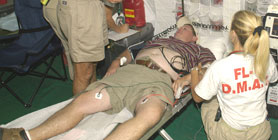
- Follow universal precautions, including washing any areas of the body or clothing that become contaminated with blood or bodily fluids
- Wash hands with soap and water every time gloves are removed. In the absence of soap and water, use an alcohol-based hand cleaner after glove removal. However, wash hands with soap and water as soon as feasible
- Do not wear PPE or clothing that has been damaged or has been penetrated by body fluids
- Report injuries and exposures to body fluid to supervisor
- Decontaminate equipment before reuse; do not reuse gloves or other disposable PPE
Additional Personal Protective Equipment
- Fluid-proof gloves (e.g., latex, nitrile, rubber). Cover with heavy-duty work gloves if potential for cuts and abrasions (e.g., moving debris)
- Protective clothing appropriate for preventing blood penetrating to underlying skin/clothing
Key Engineering Controls and Work Practices
- Assume that electrical lines are energized until proven otherwise. Lines and other conductors may become re-energized without warning as utilities are evaluated and restored after a disaster
- Inspect the work area for downed conductors and do not go near, drive over, or otherwise come in contact with them
- Downed electrical conductors can energize other objects, including fences, water pipes, bushes, trees, and telephone/CATV/fiber optic cables
- Unless deenergized and visibly grounded, maintain proper distance from overhead electrical power lines (at least 10 feet) and/or provide insulating barriers
- Do not approach any gas leaks; if a gas leak is detected, secure spark-producing devices (e.g., engines, tools, electronic, and communications equipment) and evacuate the area until the leak is secured
- Contact utility company to assist in locating, marking, and shutting off/purging utility lines that may pose a hazard or may be impacted; ensure that lines have been purged as needed before beginning work
Key Engineering Controls and Work Practices
- See Heavy Equipment and Powered Industrial Truck Use activity sheet
- See Crane Use activity sheet
- See Use of Aerial Lifts activity sheet
Additional Personal Protective Equipment
- Hearing protection—see Noise hazard
- When working from an aerial lift, use a body harness that is properly attached (or body belt for tethering or restraint use only) for fall protection
Key Engineering Controls and Work Practices
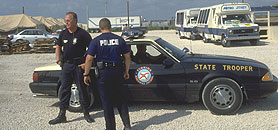
- See Work Zone Safety and Traffic Control within a Work Area activity sheet
Additional Personal Protective Equipment
- ANSI/ISEA 107-2004 compliant high visibility safety apparel and headwear
Key Engineering Controls and Work Practices
- If hazardous chemical containers are found or leaking materials are detected:
- Do not use spark-producing devices (e.g., engines, tools, electronic, and communications equipment) in the immediate area
- Take self-protective measures (i.e., move to a safe distance upwind) and contact hazardous material response personnel for evaluation/removal before continuing work in the area
- See Hazardous Waste Operations and Emergency Response (HAZWOPER) activity sheet
Additional Personal Protective Equipment
- Evaluate the need to revise protective clothing, respirator, and glove selection
Key Engineering Controls and Work Practices
- Use grappling poles to retrieve floating objects; take caution around floating barrels and drums, which could release hazardous substances if punctured
- Use buoys to mark underwater diving locations or locations of submerged materials
- Use additional protections, such as a lifesaving skiff and a ring buoy, as appropriate
- See Deep-Water Work/Boating Operations activity sheet as needed
Additional Personal Protective Equipment
- Coast Guard-approved Type I or II personal floatation devices
- Watertight boots with steel toe and insoles
Key Engineering Controls and Work Practices
- Inspect ladders for cracked, broken, or defective parts before use
- Do not exceed the load rating of ladders—remember that load ratings include people, tools, and equipment
- Set up ladders on stable surfaces
- Set extension or straight ladders at a 75 degree angle from the ground (1/4 foot back for every foot of rise) and provide 3 feet above an upper landing surface to ease climbing onto/descending from height
- Use non-conductive ladders (e.g., fiberglass) and exercise extreme caution when working near power lines
- Secure ladders that can be displaced by work activities; consider barricades at the base to keep traffic away
Key Engineering Controls and Work Practices
- See Diving and Diver-Support Operations activity sheet
Key Engineering Controls and Work Practices
- Confined spaces have limited means of entry or exit, are large enough to bodily enter, and may contain physical (e.g., mechanical, electrical, hydraulic, pneumatic energy; engulfment hazards; inwardly converging surfaces) or atmospheric hazards (e.g., atmospheres that are oxygen-deficient or oxygen-enriched, contain or may contain flammable gas, vapor or mist, airborne combustible dust, toxic substances, or any other atmosphere that is immediately dangerous to life or health). Examples include storage tanks, process vessels, bins, boilers, vaults, ventilation or exhaust ducts, sewers, tunnels, pipelines, and pits more than 4 feet in depth
- Hurricane-related events might introduce hazards or potential hazards into confined spaces. For example, a space might have a potential to contain a hazardous atmosphere due to the presence of decomposing organic matter, to the use of hazardous chemicals in the space, or to the performance of operations in the space, such as welding, cutting, or burning, that may create a hazardous atmosphere. Additional precautions must be taken to make the space safe for entry
- Evaluate the need for entry (i.e., placing any body part into the space); prevent unauthorized entries
- If entry is required, see Entry into Confined Spaces activity sheet
Key Engineering Controls and Work Practices
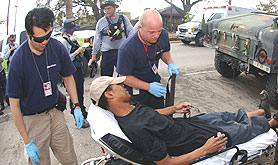
- Reduce the exposure to splash or aerosolized liquid hazards by limiting the number of people in the area and having those in the area stay upwind of water discharge areas
- Ensure that good hygiene, especially hand washing, is practiced before eating, drinking, and smoking. If clean water is not available, use an alternative such as hand sanitizer or sanitizing wipes
- Ensure that cuts and bruises are protected from contact with contaminated water
- Clean areas of the body that come in contact with contaminated water with soap and water, hand sanitizer, or sanitizing wipes
Additional Personal Protective Equipment
- Goggles if routinely working near splashing floodwater
- N, R, or P95 respirators may be necessary for exposure to contaminated water that may become aerosolized
- Watertight boots with steel toe and insoles
- Waterproof gloves for contact with contaminated water
Key Engineering Controls and Work Practices
- Limit access/set up controlled access zones
- Use fall protection systems: guardrails, safety nets, or fall arrest systems
- Cover or guard holes and openings as soon as they are created. Covers must support two times the weight (body, equipment, materials) that may be imposed
Additional Personal Protective Equipment
- Personal fall arrest system including harnesses, lanyards, lifelines, connectors, anchorages, and anchor points (as needed)
Key Engineering Controls and Work Practices
- Place generators, compressors, and other noisy equipment at a distance or behind a barrier when possible
Additional Personal Protective Equipment
- Hearing protection when working around potential noise sources and when noise levels exceed 90 dBA. A useful "rule of thumb"—if you cannot hold a conversation in a normal speaking voice with a person who is standing at arms length (approximately 3 feet), the noise level may exceed 90 dBA
Key Engineering Controls and Work Practices
- Stay upwind of or away from dust-generating activities, and in particular those involving crystalline silica-containing materials like concrete, brick, tile, drywall, mortar, sand, or stone. When inhaled, the fine crystalline silica particles contained in the dust can become lodged deep in the lung, which can lead to silicosis and other respiratory illnesses
- Use water spray or mist to suppress dust generation, especially during operations that may create a lot of dust, such as cutting or sawing silica-containing materials, jack hammering, impact drilling, using heavy equipment, and demolishing structures
- Avoid using compressed air for cleaning surfaces
- Sample worker exposures to silica during dust-generating activities
- Limit contact or disturbance of surfaces containing substantial visible mold growth
Additional Personal Protective Equipment
- At a minimum, use respirators with N, R, or P95 filters for work with crystalline silica-containing materials (e.g., concrete, brick, tile, mortar). The use of N, R, or P100 filters may provide additional protection. Higher levels of respiratory protection may be needed for some operations (e.g., cutting concrete, sandblasting, mixing concrete)
- N, R, or P95 respirators may be used for nuisance dusts (e.g., dried mud, dirt, or silt) and mold (except mold remediation). Filters with a charcoal layer may be used for odors
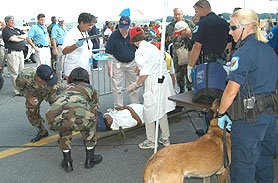
Select any of the following potential hazards that can be associated with this activity in order to access relevant recommendations in the general recommendations document:
Additional Medical Needs
- Follow medical guidance and precautions outlined in the general recommendations document
- Workers likely to contact blood and body fluids (medical and search-and-rescue personnel) should be vaccinated against hepatitis B.
Additional Training Needs
- Follow general site- and task-specific training guidelines as outlined in the general recommendations document
- Workers who may be exposed to blood or other potentially infected materials (OPIM) through contact with bleeding, injured, or sick victims must be provided with initial and annual training on bloodborne pathogens and the employer's exposure control plan, in accordance with 29 CFR 1910.1030(g).
- Public Safety personnel who are likely to respond to an emergency involving the release or potential release of a hazardous substance (e.g., oil or gasoline, chlorine, pesticides, corrosives, other chemicals) must be trained to perform their role as outlined in the Hazardous Waste Operations and Emergency Response (HAZWOPER) standard, 29 CFR 1910.120(q)(6) or 29 CFR 1926.65(q)(6). Personnel who are likely to witness or discover a release, initiate an emergency response sequence, and take no further action must receive training equivalent to the "first responder awareness level." Personnel who will take defensive action without trying to stop the release must have training equivalent to the "first responder operations level." Personnel who will respond to stop the spill must receive additional training under HAZWOPER(q)(6)
Related Activity Sheets
- Search and Rescue
- Removing Human and Animal Remains
- Locating, Collecting, and Housing Stray Animals
- Diving and Diver-Support Operations
- Deep-Water Work/Boating Operations
- Entry into Confined Spaces
- Heavy Equipment and Powered Industrial Truck Use
- Work Zone Safety and Traffic Control within a Work Area
- Crane Use
- Use of Aerial Lifts
- Hazardous Waste Operations and Emergency Response (HAZWOPER)
Other Resources and References
- 29 FR 1926.106, Working Over or Near Water. OSHA Standard.
- 29 CFR 1926 Subpart M, Fall protection. OSHA.
- 29 CFR 1910 Subpart D, Walking-Working Surfaces. OSHA.
- 29 CFR 1926 Subpart X, Ladders. OSHA.
- 29 CFR 1910.1030, Bloodborne Pathogens. OSHA Standard.
- 29 CFR 1910.120, Hazardous waste operations and emergency response. OSHA Standard.
- General Decontamination. OSHA Fact Sheet, (2005).
- Traumatic Incident Stress: Information for Emergency Response Workers. US Department of Health and Human Services (DHHS), National Institute for Occupational Safety and Health (NIOSH) Publication No. 2002-107, (October 2001).
- Portable Ladder Safety Tips. OSHA Quick Card, (2005).
- Falls. OSHA Fact Sheet, (2016).
- Working Safely Around Downed Electrical Wires. OSHA Fact Sheet (Publication 3941), (2018).
- Confined Spaces. OSHA Safety and Health Topics Page.
- Procedures for Atmospheric Testing in Confined Spaces. OSHA Quick Card, (2005).
- Storm/Flood and Hurricane Response. National Institute for Occupational Safety and Health (NIOSH) Workplace Safety and Health Topic.
- Work Zone Traffic Safety. OSHA Fact Sheet, (2005).
- Manual on Uniform Traffic Control Devices (MUTCD). US Department of Transportation, Federal Highway Administration.
- Respiratory Protection. OSHA Safety and Health Topics Page.
- NIOSH Respirator Selection Logic 2004. Centers for Disease Control and Prevention (CDC).

